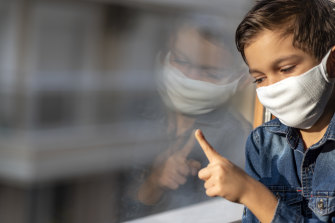What can we do as individuals to combat the winter COVID-19 wave? In the fifth instalment of a special series, The Age’s health team asks experts for the best advice on wearing masks in schools.
Schoolchildren in Victoria, Queensland and NSW are being asked, once again, to wear masks in classrooms.
We know that mask-wearing reduces our chance of catching COVID-19 – and this is especially the case with respirators such as the N95.
But is mask wearing in schools an effective tool in preventing the spread of the virus? As epidemiologists like to ask, do the benefits outweigh the costs?
Let’s look at the evidence, which at this stage looks messy.
One study by the US national health protection agency, the Centres for Disease Control and Prevention, found schools without a mask mandate had 3.5 times the number of coronavirus outbreaks as schools with one.
In contrast, a study published in Science on pandemic safety measures in schools found student masking had no significant effect on COVID-19 infection.
Australian National University infectious disease expert Peter Collignon warns that many of the studies in this field are riddled with confounding variables.
This means they fail to control for factors such as vaccination rates, the size of outbreaks and testing protocols, which means the benefits of mask wearing cannot be assessed on its own merit.
What’s lacking in the scientific literature is a robust, randomised trial that measures the effects of mask-wearing alone, Collignon said.
“Nobody has actually done those sorts of basic experiments,” he said.
Students aged eight and over are now “expected” to wear masks indoors as part of new Department of Education guidelines.Credit:iStock
Parents on the fence about sending their children to school masked should note that wearing masks at school is not altogether pointless, especially for those who are clinically vulnerable.
Fitted masks are shown to lower chances of COVID-19 infection by as much as 75 per cent, research shows.
Presumably, this would go some way to protecting children from getting infected in a school where ventilation is poor, classrooms are overcrowded or vaccination rates are low.
But what of the broader impacts of mask-wearing in schools? On this question, epidemiologists are split.
Melbourne University epidemiologist Tony Blakely said the measure was a “sensible” way to reduce the spread of the virus and would help to prevent hospitals from being pushed to the brink by the latest Omicron subvariant outbreak.
But Collignon, along with chair of epidemiology at Deakin University Catherine Bennett, said the measure failed to target the biggest spreaders of the virus: adults aged 20 to 40.
Children are half as likely to catch the virus as adults who have been equally exposed. This differs from the flu, which kids are four to five times more likely to catch.
And it’s rare for kids and teens to get severely ill with the virus – a risk that increases with age and other health vulnerabilities.
The three epidemiologists agreed, however, that mask-wearing in schools would have a marginal impact on containing the spread of the virus.
Bennett said that, as with all public health measures, the costs must be weighed against the benefits.
The benefits of mask wearing in schools were difficult to quantify, while the costs to a child’s learning were very high, she said.
“What evidence do they have to encourage schools to go this path?” she asked. “It might make a small difference, but is that small difference going to be worth the impact on kids’ education?”
Stay across the most crucial developments related to the pandemic with the Coronavirus Update. Sign up for the weekly newsletter.
Most Viewed in National
From our partners
Source: Read Full Article

